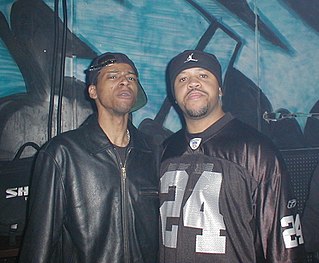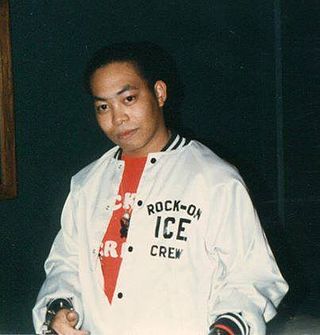History
1980s (origins)
| External audio | |
|---|---|
| Origin of Miami Bass | |
During the 1980s, the focus of Miami bass tended to be on DJs and record producers, rather than individual performers. Record labels such as Pandisc, HOT Records, 4-Sight Records and Skyywalker Records released much material of the genre. Unterberger has referred to James (Maggotron) McCauley (also known as DXJ, Maggozulu 2, Planet Detroit and Bass Master Khan) as the "father of Miami bass", a distinction McCauley himself denies, choosing rather to confer that status on producer Amos Larkins. [3] [2] DJ Kurtis Mantronik (Mantronix) was a key influence on Miami bass. In particular, Mantronik's single "Bass Machine" (1986), featuring rap vocals by T La Rock, was pivotal to the development of Miami bass. [4]
MC ADE's "Bass Rock Express" (with music and beats produced by Amos Larkins) is often credited as being the first Miami bass record to gain underground popularity on an international scale. [2]
The single "Throw The D" by the group 2 Live Crew in January 1986 gave a permanent blueprint to how future Miami bass songs were written and produced. [2]
Popularity
Luther "Luke Skyywalker" Campbell along with David "Mr. Mixx" Hobbs of 2 Live Crew played a key role in popularizing Miami bass in the late 1980s and early 1990s. The group's 1986 release, The 2 Live Crew Is What We Are , became controversial for its sexually explicit lyrics. 1989's As Nasty As They Wanna Be , along with its hit single "Me So Horny", proved more controversial still, leading to legal troubles for both 2 Live Crew and retailers selling the album (all charges were eventually overturned on appeal). [2]
For the better part of the mid-'80s and early '90s, DJs such as Luke Skyywalker's Ghetto Style DJs, Norberto Morales' Triple M DJs, Super JD's MHF DJs, Space Funk DJs, Mohamed Moretta, DJ Nice & Nasty, Felix Sama, DJ Spin, Ramon Hernandez, Bass Master DJs, DJ Laz, Earl "The Pearl" Little, Uncle Al, Ser MC, Raylo & Dem Damn Dogs, DJ Slice, K-Bass, Jam Pony Express and others were heavily involved in playing Miami bass at local outdoor events to large audiences at area beaches, parks, and fairs.
Clubs in South Florida, including Pac-Jam, Superstars Rollertheque, Bass Station, Studio 183, Randolphs, Nepenthe, Video Powerhouse, Skylight Express, Beat Club and Club Boca, were hosting bass nights on a regular basis. Miami radio airplay and programming support was strong in the now defunct Rhythm 98, as well as WEDR and WPOW (Power 96).
Contribution and promotion of Miami bass also came out of Orlando. 102 Jamz (WJHM), a prominent Orlando radio station in the late '80s, featured Miami bass and helped its popularity rise in and around Central Florida.
Florida breaks was heavily influenced by Miami bass in addition to elements of house, and deep bass that eventually created "The Orlando Sound". Thus, Miami bass quickly became a Florida staple.
1990s
By the mid-1990s, the influence of Miami bass had spread outside South and Central Florida to all areas of Florida and the Southern United States. In the mid-1990s, it saw a commercial and mainstream resurgence, with Miami bass influenced artists such as L'Trimm, 95 South, Tag Team, 69 Boyz, Quad City DJ's and Freak Nasty all scoring big Miami bass hits. Examples of these songs are "Whoomp! (There It Is)" by Tag Team in 1993, [5] "Tootsee Roll" by 69 Boyz in 1994, [6] "C'mon N' Ride It (The Train)" by the Quad City DJ's in 1996 [7] and "Whoot, There It Is" by 95 South in 1993. [5]
These songs all reached the top 20 on the Billboard Hot 100 chart and exposed Miami bass nationally. These artists generally used a Miami bass sound and production but did it in a far less explicit and far more accessible way than had been previously done by Campbell and the 2 Live Crew. [8]
Miami bass is closely related to the electronic dance music genres of ghettotech and booty house, genres which combine Detroit techno and Chicago house with the Miami bass sound. Ghettotech follows the same sexually oriented lyrics, hip-hop bass lines and streetwise attitude, but with harder, uptempo Roland TR-909 techno-style kick beats. In 2007, contemporary hip-hop and R&B songs became more dance oriented, showing influences of Miami bass and techno, and are typically sped up to a "chipmunk" sound for faster tempos for dances such as juking, wu-tanging and bopping (usually only done in Miami-Dade, Broward and Palm Beach Counties in south Florida).[ citation needed ]
Subgenres
Miami bass has been influenced by the cultural history of its wide-ranging community with the evolution of Cuban, Dominican, and Afro-Brazilian-fused sub-genres that include Baltimore club and funk carioca. [9] [10]
Another subgenre of Miami bass is "car audio bass", which features an even more stripped down bass-heavy sound, tending to focus on either extremely hard 909 kicks combined with sine waves or the classic 808 kick, or sometimes simply the sine wave by itself.[ citation needed ] Some artist examples would be DJ Laz, DJ Magic Mike, Afro-Rican (as Power Supply), Techmaster P.E.B., DJ Billy E, Bass 305 and Bass Patrol.



